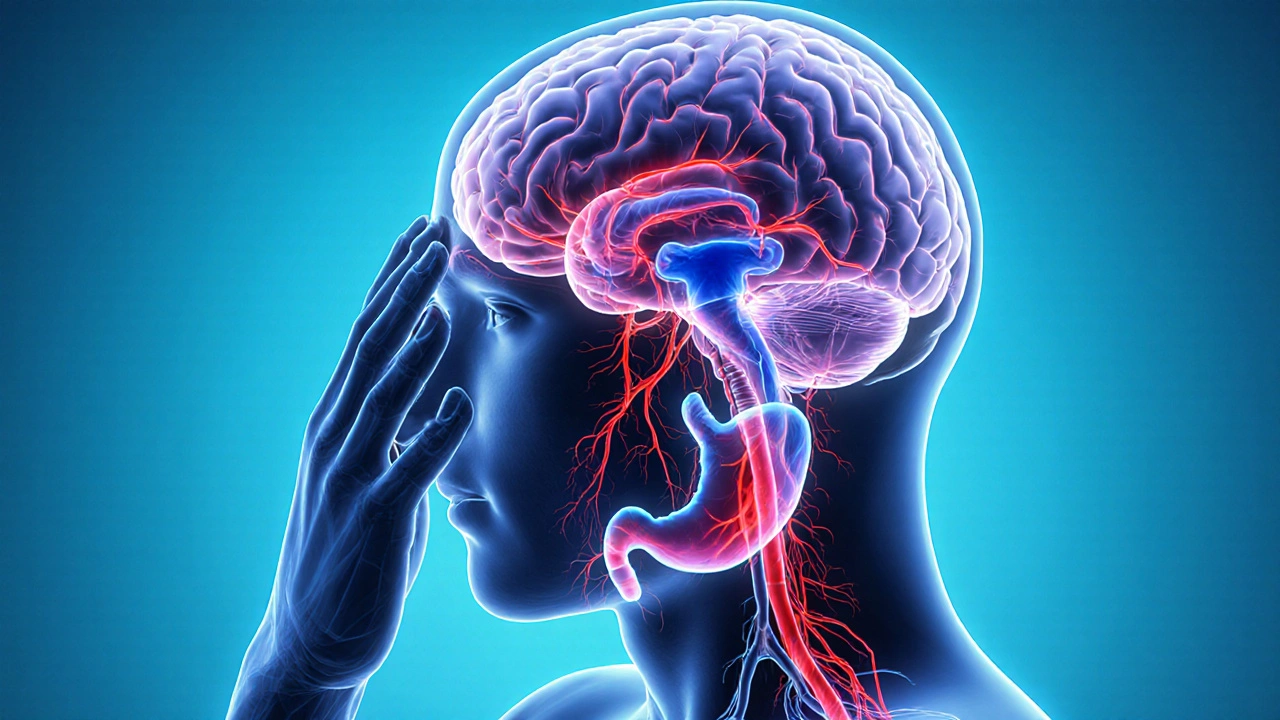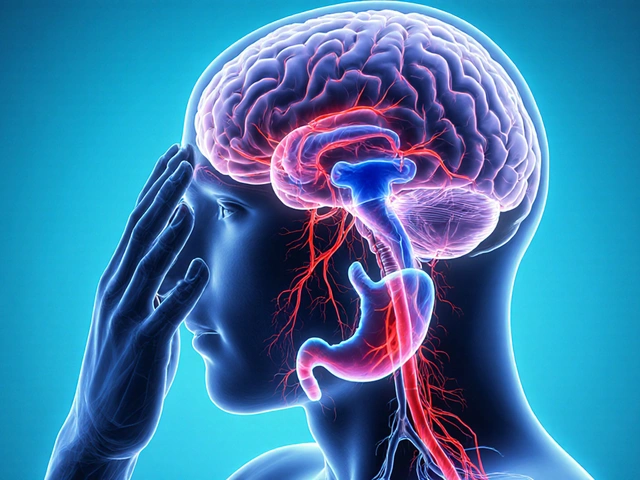Migraine & Nausea Symptom Tracker
Migraine Symptoms
Headache, throbbing pain, sensitivity to light/sound
Nausea Symptoms
Feeling sick, urge to vomit, stomach discomfort
Track Your Symptoms
Your Symptom History
No symptoms logged yet. Start tracking your symptoms above.
Common Triggers
Hormonal
Estrogen fluctuations during menstrual cycle
Stress & Sleep
Cortisol spikes and fatigue
Food
Processed meats, aged cheeses, artificial sweeteners
Environment
Bright lights, strong odors, altitude changes
TL;DR
- Nausea accompanies migraines in up to 80% of cases, driven by shared brain pathways.
- Key chemicals: serotonin and CGRP, both affect pain and gut motility.
- Typical triggers-hormonal shifts, stress, certain foods-can spark both symptoms.
- Effective relief often combines anti‑emetics, NSAIDs, and preventive migraine meds.
- If nausea is severe, persistent, or paired with vision changes, see a clinician quickly.
What’s really happening when nausea tags along with a migraine?
Most people think of a migraine as just a pounding head ache, but the reality is far richer. When Nausea is defined as a feeling of sickness that creates an urge to vomit, it often arises from the same nervous‑system flare‑up that fuels the throb in the skull. In fact, clinical surveys from 2023 show that between 70 and 80% of migraine sufferers report at least mild nausea during an attack.
Biology behind the link
Two neurotransmitters dominate the conversation: serotonin (a brain chemical that regulates mood, pain, and gut function) and CGRP (calcitonin gene‑related peptide, a peptide that dilates blood vessels and triggers inflammation). During a migraine, serotonin levels dip sharply, prompting the brain’s trigeminovascular system to release CGRP. The resulting vessel dilation sends pain signals, while the same serotonin drop slows gastric emptying, setting the stage for nausea.
Think of it as a party that got out of control: the brain invites pain‑related guests (CGRP) and then forgets to tell the stomach that dinner is over, so the stomach keeps complaining.
Common triggers that pull both strings
Because the same pathways are involved, many migraine triggers double‑dip into nausea. Below is a quick rundown of the most frequent culprits:
- Hormonal fluctuations - estrogen drops before menstruation can plunge serotonin, sparking both head pain and stomach queasiness.
- Stress & lack of sleep - cortisol spikes amplify CGRP release, while an exhausted gut becomes sluggish.
- Food triggers - aged cheeses, processed meats, and artificial sweeteners contain tyramine or glutamate, both known to provoke migraines and upset the gut.
- Environmental factors - bright lights, strong smells, and altitude changes can set off the trigeminovascular cascade, often with a side of nausea.
Keeping a simple diary (date, food, mood, symptoms) helps pinpoint your personal pattern in just a few weeks.

When nausea points to a specific migraine subtype
Not all migraines are created equal. Vestibular migraine (a migraine variant where dizziness and balance loss dominate the picture) frequently features nausea as a primary complaint, sometimes even before the head ache starts. In contrast, classic migraine with aura may give visual flashes first, with nausea following later.
Below is a side‑by‑side look at the two most common forms:
| Feature | Classic Migraine | Vestibular Migraine |
|---|---|---|
| Primary pain location | Unilateral, throbbing | Often bilateral, pressure‑like |
| Aura | Visual flashes in ~25% of cases | Rare, but may include auditory disturbances |
| Dizziness | Occasional | Core symptom - spinning or swaying |
| Nausea | Common (60‑80%) | Very common (70‑90%) |
| Duration | 4‑72hours | 30minutes‑ several days |
Managing the double‑hit: practical treatment tips
Because the link is biochemical, the most effective plans attack both fronts.
- Acute meds: Combine a triptan (e.g., sumatriptan) with an anti‑emetic (a drug that blocks nausea signals, such as metoclopramide or prochlorperazine). This duo tackles pain and the stomach simultaneously.
- NSAIDs: Ibuprofen or naproxen reduce inflammation and also help settle the gut by lowering prostaglandin levels.
- Preventive therapy: If attacks recur more than four times a month, consider daily CGRP monoclonal antibodies (e.g., erenumab) or beta‑blockers. These lower overall CGRP spikes, indirectly calming nausea.
- Lifestyle hacks: Hydrate early, eat a small bland snack (plain crackers, ginger tea) as soon as aura begins, and practice scheduled sleep‑wake cycles.
Many patients swear by ginger-its gingerol compounds can calm the stomach without interfering with migraine meds.
Red flags: when nausea isn’t just a migraine side effect
If any of the following pop up, seek medical care right away:
- Sudden, severe headache that peaks within minutes (possible subarachnoid hemorrhage).
- Persistent vomiting for more than 24hours.
- Neurological signs: double vision, slurred speech, weakness.
- New onset after age 50, especially if accompanied by weight loss.
These cues may point to infections, stroke, or even a gastrointestinal blockage that needs urgent attention.
Quick reference checklist
- Track triggers in a journal - food, stress, sleep, hormones.
- Keep triptan + anti‑emetic on hand for early use.
- Stay hydrated; sip water or electrolyte drinks.
- Try ginger tea or chews at the first sign of nausea.
- Review preventive options with your doctor if attacks are frequent.
Frequently Asked Questions
Why does nausea often start before the migraine headache?
The brainstem houses the vomiting center and the trigeminovascular system. Early CGRP release can stimulate both pain pathways and the nausea center, so the gut may complain first.
Can over‑the‑counter (OTC) meds replace prescription treatments?
OTC NSAIDs help many mild attacks, but they rarely address the underlying CGRP surge. For frequent or severe nausea‑migraine combos, a prescription triptan plus anti‑emetic works faster and more reliably.
Is vestibular migraine more common than classic migraine?
Studies from 2022 estimate vestibular migraine affects about 1% of the general population, while classic migraine hits roughly 12%. So it’s less common overall, but among migraineurs it accounts for up to 30% of cases.
Are there natural remedies that actually work?
Ginger, magnesium citrate, and riboflavin (vitaminB2) have modest evidence for reducing migraine frequency and easing nausea. They’re safe adjuncts but shouldn’t replace proven meds for intense attacks.
When should I consider seeing a neurologist?
If you have more than four migraine‑related episodes per month, if nausea is disrupting daily life, or if you notice new neurological signs, a specialist can tailor preventive therapy and run imaging to rule out secondary causes.








Write a comment
Your email address will be restricted to us